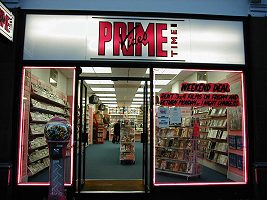|
Temple/London
Fall 1999 |
|
|
Temple/London
Fall 1999 |
|
Form:Technical Quality
(Production Values)
by
C. Koutavoulis and R. Ellerson
The Question
Are the production values of British media superior to the U.S.? To research production qualities, the study examined British and U.S. Television and films. Production values were defined in TV as background (set), editing, audio, lighting and camera steadiness. In film, production values were defined as special effects, editing, audio, lighting and camera steadiness. The purpose is to see whether or not British production values are superior to U.S. production values in the media.
![]() Methods/Results: Television
Methods/Results: Television
To analyze production values on TV, two major channels for three 2-hour intervals were selected, recorded, and viewed. In order to compare production qualities between British and U.S. TV a scale was created. The scale created for the research of production values counts every time an error was made in the set, editing, audio, lighting, and camera steadiness. More specifically, if the set is of poor quality, the editing jumps, the lighting is to dim or bright, and the camera isn’t steady. The local London channels (BBC1, BBC2, ITV-3, CH.4, and CH.5) were placed in a hat and two were randomly selected. The two London channels selected and viewed were BBC 1 and ITV-3. Next, the local N.Y. channels (5, 7, 9, 11, 13, 21, 41, and 47) were placed in a hat and two were randomly selected. The two N.Y. channels selected and viewed were Channel 7 ABC and Fox 5. Both London and New York channels were viewed on Thursday November 4, 1999. Three time slots were randomly selected; they were 6.00-8.00, 12.00-14.00, and 18.00-20.00.
The research showed production values in British TV programming are of lower quality (more errors). The amount of errors between British and U.S. TV programming was a small difference. Throughout the six hours studied there were a total amount of four errors in British production values. The total amount of errors in U.S. production values was three. British production values had more errors in editing, audio, camera steadiness and lighting while U.S. production values had errors in audio and camera steadiness.
![]() Methods/Results:
Film
Methods/Results:
Film

To research film, the London Time Out issue number 1524, November 3-10 1999, provided a listing of the top U.S. film rentals in the U.K. The forty-third London Film Festival magazine, November 3-18 1999, provided the top British films that made an impact in the U.S. In order to compare production qualities between British and U.S. films a scale was created. The scale that was created for the research of production values counted every time an error was made in special effects, editing, audio, lighting, and camera steadiness. The scale also looked at, more specifically, if the special effects looked unrealistic, the editing jumped, the lighting was to dim or bright, and the camera wasn’t steady. The two British films Lock, stock, and Two Smoking Barrels and Elizabeth were selected from the London Film Festival magazine. The two U.S. films selected were The Faculty and eXisteNz. The films were rented from Prime Video that is located on the corner of Bloomsbury and Southampton Row. Every film was viewed completely to the end.
The research showed the production values in British film are of equal quality as compared to the production values in the U.S. The total amount of errors in British production values was 0. The total amount of errors in U.S. production values was 0.
Conclusions
Media production values were similar. The research found British not equal in the TV time slots studied to the U.S. In British TV, the production values were lower quality (more errors) than in U.S. TV production values. In British film, the production values were equal to the U.S. production values. Possible psychological questions include; what is the effect of lower quality production values to the media consumer? Does the media consumer experience any negative or positive emotion if they notice that the production values are a greater or lower quality in the particular media?
Sources/For More Information
Types of production |
Ratings |
|||||||
values |
||||||||
Excellent* |
Average** |
Poor*** |
||||||
Special effects |
0 |
|||||||
Editing |
0 |
|||||||
Audio |
0 |
|||||||
Lighting |
0 |
|||||||
Types of production |
Ratings |
|||||||
values |
||||||||
Excellent* |
Average** |
Poor*** |
||||||
Special effects |
0 |
|||||||
Editing |
0 |
|||||||
Audio |
0 |
|||||||
Lighting |
0 |
|||||||
Form: Technical Quality "production values" in British Films |
||||||||
Types of production |
Ratings |
|||||||
values |
||||||||
Excellent* |
Average** |
Poor*** |
||||||
Special effects |
0 |
|||||||
Editing |
0 |
|||||||
Audio |
0 |
|||||||
Lighting |
0 |
|||||||
Camera steadiness |
0 |
|||||||
Types of production |
Ratings |
|||||||
values |
||||||||
Excellent* |
Average** |
Poor*** |
||||||
Special effects |
0 |
|||||||
Editing |
0 |
|||||||
Audio |
0 |
|||||||
Lighting |
0 |
|||||||
Camera steadiness |
0 |
|||||||
* no errors |
||||||||
**1-3 errors |
||||||||
***4 or more errors |
||||||||
![]()